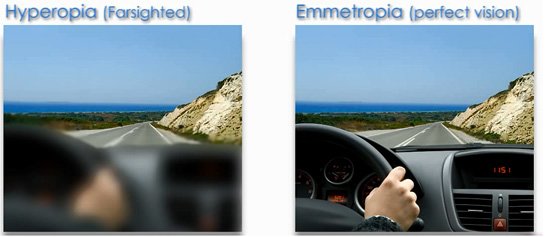Hyperopia also known as Hypermetropia or Farsightedness is a common defect in our vision. Hyperopia is caused by a certain eye imperfection that results to difficulty of the eye to focus on objects close to us. It is also known as long-sightedness and is the total opposite of myopia.
People with farsighted vision have various difficulties. When an object comes into view, the eye has a responsibility of increasing optical power to bring the focus of the image towards the retina. If images seen by sufferers become blurred, it is because the power given out by the lens and the cornea is insufficient.
Related Link: How to restore vision naturally?
What Causes Hyperopia or Farsightedness?
In this particular eye imperfection, the condition of the cornea is either flat or lacks in curvature that is why focusing is not accurate wherein the lens cannot adjust itself into becoming round in order to focus on objects well.
It is also said that people who are afflicted by Hyperopia have a short eyeball; meaning there is a decrease in distance between the retina and eye lens. In severe cases, a person suffering from Hyperopia may also find it hard to focus on anything at any distance at all.
Patients with Acute Hyperopia see objects clearly only from a distance, while those on the milder level may see close objects clearer. People with Hyperopia exert more effort compared to those with normal eyesight. This eye defect is commonly congenital and inherited.
Hyperopia or Farsightedness in Children
Most children woke up in the world with Hyperopia but some may outgrow the defect after the eyeball gets lengthened by normal growth. At birth, the brain would find it hard to merge images that the eyes see. This is due to the blurred images sent by the eye to the brain.
Studies revealed that children who have manifested severe symptoms of Hyperopia never saw details in objects they see. Some have reportedly saw manifestations of Strabismus or Amblyopia.
Therefore, once the brain fails to see the details, then, there is a risk of having one eye dominant over the other. It is the same in saying that when the brain blocks the impulses of the inferior eye, this results to either Amblyopia or Strabismus.
A child suffering from Hyperopia commonly stays close to a TV set while most of us expect them to sit at the farthest point of the room just because they are afflicted with the defect. The patients would get blurry eyesight because their brains fail to distinguish details and shapes of objects. It is at this point where they would unknowingly use a squint.
Squinting is a natural reaction of the eye muscles to make the viewer’s brain detect lines and shapes. This also enables the brain to map separate images from both eyes in order to form a single image. Visual perceptions from both eyes are different because each of them functions differently.
Children with Hyperopia Can’t See Objects in 3D
Parents of the children with Hyperopia may not realize their kids are suffering from the affliction until they notice them not being able to catch a ball while at play. Balls are round and children Hyperopia are unable to see objects in 3D.
Related Links

Leave A Comment